
About UsThe Numismatic Bibliomania Society is a non-profit organization promoting numismatic literature. For more information please see our web site at coinbooks.org SubscriptionsThose wishing to become new E-Sylum subscribers (or wishing to Unsubscribe) can go to the following web page link MembershipThere is a membership application available on the web site Membership Application To join, print the application and return it with your check to the address printed on the application. Membership is only $15 to addresses in the U.S., $20 for First Class mail, and $25 elsewhere. For those without web access, write to: David M. Sundman, Secretary/TreasurerNumismatic Bibliomania
Society AsylumFor Asylum mailing address changes and other membership questions, contact David at this email address: dsundman@LittletonCoin.com SubmissionsTo submit items for publication in The E-Sylum, just Reply to this message, or write to the Editor at this address: whomren@coinlibrary.com
BUY THE BOOK BEFORE THE COINYou won't regret it! |
- WAYNE'S WORDS: THE E-SYLUM MAY 9, 2010
- NEW BOOK: WORLD PAPER MONEY ERRORS BY MORLAND FISCHER
- NEW BOOK: BOSTON NUMISMATIC SOCIETY 150TH ANNIVERSARY REDBOOK
- CANADIAN CLUBS BROADEN ACCESS TO JOURNALS
- TRIP REPORT: LEN AUGSBURGER VISITS ANNAPOLIS AND WILMINGTON
- HARRY WATERSON'S TOP TEN REASONS TO READ THE E-SYLUM
- QUIZ ANSWER: WHO IS THE MYSTERY NUMISMATIST?
- QUERY: J. GOLDSBOROUGH BRUFF
- SUSAN TRIPP'S EVERGREEN HOUSE LECTURE
- GOLD CONFEDERATE CENT RESTRIKES
- QUERY: CONFEDERATE CENT RESTRIKES IN OTHER METALS SOUGHT
- DICK JOHNSON: GLOSSARY TERMS OFTEN MISLEADING
- POLITICAL SHAKEUPS AT THE U.S. MINTS
- QUERY: 2008, 2010 SPECIAL EDITION RED BOOKS
- QUERY: MERKIN, CHAPMAN AND LIMPERT PHOTOS SOUGHT
- QUERY: UNKNOWN COPPER TOKEN IDENTIFICATION SOUGHT
- THE EMERGENCY MONEY COLLECTOR, VOL. 2 NO. 2
- MICHAEL MAROTTA ON NUMISMATICS AND THE LAW
- NOTES FROM E-SYLUM READERS: MAY 9, 2010
- QUERY: NEW ENGLAND NUMISMATIC AND ARCHAEOLOGICAL SOCIETY PRLS
- QUERY: COLLECTORS OF CANADIAN TOKENS AND MEDALS SOUGHT
- MORE ON THE PAPERS OF CHARLES EDWARD BARBER
- QUERY: FRANCIS SHALLUS, PHILADELPHIA ENGRAVER
- GIANT CHINESE COIN OF LE DYNASTY FOUND
- ARTICLE ON STATE DEPARTMENT'S COIN IMPORT RESTRICTIONS
- IN POLL CANADIANS VOTE AGAINST KEEPING THE CENT
- SHADES OF STANDING LIBERTY: VIRGINIA'S BARE BREAST COVERED
- BOOK QUOTE OF THE WEEK: JOHN RUSKIN
- MOTHER'S DAY COMMEMORATIVE COIN ACT PASSES U.S. HOUSE
- FEATURED WEB SITE: NATIONAL MARITIME MUSEUM
WAYNE'S WORDS: THE E-SYLUM MAY 9, 2010

Among our new subscribers this week are Robert Stump, courtesy of Harold Levi, and Jeff Fournier. Welcome aboard! We now have 1,339 subscribers.
This week we open with information on two new books and word of novel arrangement between two Canadian clubs to broaden access to their journals. Next up is a trip report from Len Augsburger with word of an interesting discovery.
There are several reader queries this week. Topics include J. Goldsborough Bruff, Francis Shallus, Frank Limpert and the New England Numismatic and Archeological Society.
To learn about Henry Voigt's account book, the identity of our camel-riding numismatist and political shakeups at the U.S. Mints, read on. Have a great week, everyone!
Wayne Homren
Numismatic Bibliomania Society
NEW BOOK: WORLD PAPER MONEY ERRORS BY MORLAND FISCHER
Collectors worldwide have been anticipating the arrival of World Paper Money Errors by Morland Fischer. Now available, this one of a kind reference guide offers pricing for international error notes in striking full color.
World Paper Money Errors tailors to the young hobby of collecting foreign currency errors. Readers will learn how mistakes are created during the production process, the difference in market prices of United States error notes versus international error notes and more about this growing branch within numismatics. Featuring over 200 unusual and rare currencies, Morland Fischer has categorized his vast collection into 19 types of errors. Each error note is presented alongside a correct note to emphasize the shocking shapes and distorted designs that contribute to the value of the notes.
- Comprehensive collection featuring rare notes from over 70 countries.
- Provides descriptions and examples for 19 types of errors.
- Insightful comparison between domestic and foreign currency
- Explanation of valuing notes using an innovative Foreign Error Note (FEN) Scale
- Market price for each featured error note.
Exhibiting hundreds of extraordinary banknotes from around the world, numismatists and spectators alike will be intrigued by the currencies that are scarcely seen by the public. World Paper Money Errors enhances this new and advancing form of collecting.
Please call if you wish to request additional information. Contact: Jessica Mullenfeld, Zyrus Press, at www.zyruspress.com.
NEW BOOK: BOSTON NUMISMATIC SOCIETY 150TH ANNIVERSARY REDBOOK
 2011 Guide Book of United States Coins
2011 Guide Book of United States Coins
Special Commemorative Edition
Boston Numismatic Society 150th Anniversary
With the 150th anniversary of the Boston Numismatic Society coinciding with the 2010 Annual Convention of the American Numismatic Association in Boston, we thought it appropriate to work with Whitman Publishing Company to produce a special edition of the 2011 Red Book. Commemorating a significant milestone of the third oldest numismatic society in the United States, the result has been the best executed of any of the special editions.
Improving on the concept used with the 1987 Milwaukee edition, we asked the Society to identify three members, past or present, who have contributed greatly to its success over the past 150 years. Selected were Sylvester S. Crosby, William Sumner Appleton, and Arthur M. Fitts.
Working from photographs that we supplied, Whitman produced a cover with an excellent likeness of each, the B.N.S. logo and the words “Boston Numismatic Society. 1860-2010. Commemorating 150 years.”
The edition consists of 450 numbered copies (500 were ordered, 450 were delivered) with each bearing an attractive bookplate produced by letterpress in red and black ink with the book's serial number added in gold by a calligrapher.
In addition, an accomplishment card, also executed by letterpress, for the three honorees has been laid into each copy. The books will be available May 15. We did not ask Ken Bressett to sign bookplates or leaves later to be glued in as has been done with most other special editions as we do not feel that constitutes a signed book. Ken has indicated he will be available at the Boston convention August 3-8 to autograph copies.
The price has been set at $85.00 plus $5.00 shipping. Checks should be made payable to the undersigned. Paypal is available at Numislit@aol.com
Charles Davis
Numismatic Literature
Box 547 Numislit@aol.com
Wenham MA, 01984
(978) 468 2933
THE BOOK BAZARRE
CANADIAN CLUBS BROADEN ACCESS TO JOURNALS


The Ottawa Coin Club (OCC) and the Edmonton Numismatic Society (ENS) have signed a memorandum of understanding that allows members of one club to join the other at a discounted rate.
“The whole idea came when I saw, for the first time, a copy of The Planchet, the journal of the ENS,” explains Serge Pelletier, editor of moneta, the journal of the OCC. “I was quite surprised to see how close our editorial approaches were.”
Roger Grove, editor of The Planchet, concurs “I was equally astonished when I saw moneta for the first time! “Here we are, two guys putting together local numismatic journals at opposite ends of the country, with the same approach to layout and editorial content. And we did not even know one another!”
Like-minded in many ways: But the similarities do not stop there. “Like us, the ENS hosted a very successful RCNA convention” continues François Rufiange, president of the OCC.
“It was also clear that both clubs are very invested in the promotion of both numismatics and money collecting,” says David Peter, president of the ENS, “so when the OCC proposed the idea, we jumped on it!”
How it works: The way it works is really quite simple. Folks join one of the clubs, which becomes their ‘home club', and then they can join the other club at the discounted rate. What's in it for the collector? More reading! Both editors have agreed to coordinate their publications. This means you will not see the same article published in both journals (except for book reviews, which are not considered articles). So a collector may have as much as 40 to 60 (letter size) pages illustrated with large photographs in full colour to read!
“It's a win-win situation for the clubs as well as the members” says Grove.
“We're hoping it's the beginning of a beautiful relationship!” adds Pelletier laughing.
For more information on each club, please visit their respective websites at: www.edmontoncoinclub.com and www.ottawacoinclub.com .
For more information contact:
- Serge Pelletier, 613-949-9541 (day), serge_pelletier@sympatico.ca
- Roger Grove, 780-297-1012, grove_ra@shaw.ca
TRIP REPORT: LEN AUGSBURGER VISITS ANNAPOLIS AND WILMINGTON
During the recent EAC in Annapolis I was able to make a side trip to the Hagley Library in Wilmington. This was carefully timed so as not to miss John Kraljevich's excellent walking tour of old Annapolis. I had been to Annapolis probably half a dozen times to do work at the Maryland State Archives for the Baltimore gold hoard book, but such was my monomania that I had only visited two places in the city, the Archives and a pizza place in the strip mall a little bit west of there.
The dignity of that book was such that I could not discuss how great the pizza was, fortunately The E-Sylum has enough latitude for such digressions. Did I mention that the pizza was really good? There were great documents in the Archives, too.
But it was all superseded by John's walking tour, which included the Charles Carroll house (a plaque bears a reproduction of the Charles Carroll medal by Christian Gobrecht), and the possible "first Mint" of the United States, where the Chalmers pieces may have been struck (later at the EAC, Will Mumford gave a fascinating talk about his excavation of the property, which uncovered a Chalmers piece buried in the cellar).
Now on to Hagley - this is the old DuPont family library, now open to the public, and the grounds are spectacular. The reading room would make Thoreau proud - curators bringing old books on one side and a floor to ceiling view of unspoiled countryside on the other.
Hagley has a strong collection of industrial trade catalogs, and I had known for some time that they had a number of early Frank H. Stewart Electric Company catalogs which are probably unique - not even present in Stewart's personal papers at Rowan University. These lent some additional insight on the early days of the company (prior to their acquisition of the first U.S. Mint building in Philadelphia), but the real prize was something I found by sheer luck while cruising their online catalog prior to visiting.
Catalogued as an "account book of the chief coiners of the United States Mint," hopes were raised that this was the long lost first account book of Henry Voigt from 1792, obliquely referred to in Snowden's Mint Manual (1860) and missing ever since. I didn't get that lucky, but what we have here is a personal account book of Voigt which indicates a business relationship with Adam Eckfeldt, outside of the Mint, personal loans to John Reich, and a possible accounting of Jefferson inauguration medals (Julian PR-2).

The book was acquired by Hagley in the 1960s - where it was before that is anyone's guess, although certain notations in the book suggest it stayed in the Voigt family. Further study is underway and will be published in due course. I can't imagine anyone (with the possible exception of Eric Newman!) would have found this without an online catalog, and we are fortunate to live in the era where all these resources are first appearing and we get to be the ones to harvest them.
Joel Orosz adds:
If there is such a thing as a bloodhound of numismatic research, his name is Len Augsburger! Not even Bob Julian knew of the existence of this ledger before Len unearthed it.
By the way, since Len mentioned Eric Newman, and he's got a birthday coming up. On May 25 he'll be 99! Go, Eric!
Below is some more information on the Hagley, which sounds like a great resource. -Editor
Hagley Museum and Library collects, preserves, and interprets the unfolding history of American enterprise. Hagley is located on 235 acres along the Brandywine River near Wilmington, Delaware.
The Hagley Library is the nation's leading business history library and archives. It is organized into five departments: Manuscripts and Archives, Pictorial Collections, Imprints, Conservation, and the Center for the History of Business, Technology, and Society.
Hagley's collections document business activities since the late eighteenth century as well as the interaction between business and the cultural, social, and political dimensions of our society. Researchers come to Hagley from all over the world to use our resources in studying a wide array of subjects, as business records and personal papers are relevant for many interests and projects. Travel grants are available to support research visits.
To learn more about the Hagley library, see: About the Hagley Library (www.hagley.org/library/about/)
HARRY WATERSON'S TOP TEN REASONS TO READ THE E-SYLUM
Drum-roll...
10. Read the E-Sylum every week and learn stuff.
9. Pick up on A Gentle Madness by Nicholas Basbanes 15 years after publication.
8. Read A Gentle Madness.
7. Have a serious re-evaluation meeting with oneself.
6. Call the Springfield Art Museum to see if they will take one's Western Art/Frederic Remington collection.
5. Revise the donation bibliography deleting the books one just can't do without.
4. Give the undeleted books to the Museum Library.
3. Get a 1st refusal on any book the Library decides it doesn't want.
2. Put numismatic books onto the newly available shelf space.
1. Re-arrange the numismatic books again and again until one gets it right. Continue as required.
THE BOOK BAZARRE
QUIZ ANSWER: WHO IS THE MYSTERY NUMISMATIST?

Nick Graver writes:
I cannot identify the numismatist in the photo post card, but he is pictured in front of the Great Sphinx and in the background is the second tallest of the three Great Pyramids at Giza, on the outskirts of Cairo, Egypt. This pyramid of Khafre (or Chephren) retains a major portion of its original smooth dressing which shows in the photo. The number 9 at the bottom tied the prints to the customer's order after processing.
Dick Margolis writes:
I don't think the mystery numismatist is much of a mystery; he very much looks to me like Abe Kosoff doing the obligatory tourist bit on a camel, in front of the Sphinx, in February or March 1954 while he was in Cairo attending the Farouk sale.
Alan Weinberg writes (with the subject line "the dude on the camel"):
I'm gonna guess it's Abe Kosoff on a camel while visiting Cairo for the Farouk numismatic auction in 1954.
Larry Dziubek writes:
Howard Gibbs at the Farouk Sale, most likely after he got out of jail. He worked for coal companies and was used to carrying a gun at all times. I believe he was arrested for carrying a weapon as he deplaned in Egypt. He was not held very long and did not miss the sale as I recall. I wonder if this story was told by Schulman in one of the Gibbs sale catalogs?
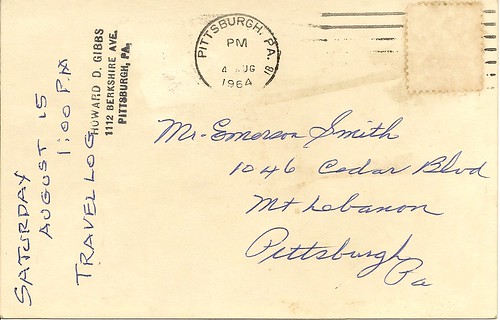
Dick Margolis adds:
I knew Howard very well, even had dinner at his house in Pittsburgh, but didn't know about his 1964 Egyptian trip. His wife, a very good cook, was famed quarterback Johnny Unitas's mother. How is that for a bit of numismatic-related trivia?
Now - who will serve up the next numis-mystery for us to solve? -Editor
To read the earlier E-Sylum article, see: QUICK QUIZ: WHO IS THE MYSTERY NUMISMATIST? (www.coinbooks.org/esylum_v13n18a22.html)
QUERY: J. GOLDSBOROUGH BRUFF
This isn't exactly a numis-mystery, but while looking things up in Dave Bowers' American Numismatic Association Centennial History, I came across this reference to another coin and medal artist I hadn't heard of:
... an autographed letter by James Ross Snowden, Director of the Philadelphia Mint, which discussed a pattern double eagle design by I. Goldsborough Bruff, of Washington, D.C.
SUSAN TRIPP'S EVERGREEN HOUSE LECTURE
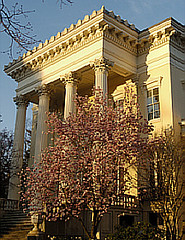 Last Wednesday (April 28), I had the pleasure of attending a presentation by Susan Tripp, the former curator of the Evergreen House, once the home of the Garrett family and their remarkable numismatic collection. Her presentation, “Discovering Evergreen,” was a part of The House Beautiful Lecture Series held at Evergreen in the spring.
Last Wednesday (April 28), I had the pleasure of attending a presentation by Susan Tripp, the former curator of the Evergreen House, once the home of the Garrett family and their remarkable numismatic collection. Her presentation, “Discovering Evergreen,” was a part of The House Beautiful Lecture Series held at Evergreen in the spring.
The main part of the lecture focused on her interesting (and sometimes amusing) experiences as curator of Evergreen and the $4.3 million restoration of the building that she oversaw. Although I went primarily to see what she had to say about the numismatic collection, I enjoyed hearing her stories about the house, the collections, the Garretts, and other personalities.
Susan told how she came to Evergreen in 1974, succeeding the previous curator Sally Freeman, who had retired. Her first goal was to organize and catalog the collection so that the Johns Hopkins University and the Evergreen House Foundation could ultimately determine what to sell. The house was filled with objects; not just from the Garrett collections, but from the entire university. She was guided by Elizabeth “Libby” Baer, who had been John Work Garrett's librarian since 1936 and was now the Director of the Evergreen House Trust.
Sally Freeman began working with the coin collection in 1955 and added notations to the Garretts' index card filing system. John Work Garrett's library was apparently the center of the household, and he often entertained and ate his meals there. The ingenious coin dumbwaiter that Garrett had installed to bring coins up from his vault meant that he would never have to leave his favorite room in the house.
Susan told an amusing anecdote about how, while she was preparing the numismatic collection for sale, she would often work downstairs in the vault beneath the library. When a tour would come by the security guard would yell down to alert her and then shut the hatch. After the tour had finished the security guard would open the vault and check on her. This worked fine until one time they closed the hatch without realizing she was down there and eventually went looking for her when she was not at lunch. (She was fine.)
Susan spoke only briefly about the sale of the Garrett numismatic collection. Sotheby's had been providing significant help to the Evergreen House because they knew that the Foundation and University were interested to sell. Apparently they were a bit annoyed that the first Garrett coins went to Stack's in March 1976. (Sotheby's was still given a Picasso, among other items, to sell.) The bulk of the collection, however, would eventually be sold by Bowers and Ruddy and Numismatic Fine Arts.
Overall, Susan Tripp's lecture at the Evergreen House was enlightening and it was great to hear the perspective of a former curator. She has an abundance of interesting stories and is highly knowledgeable. While the Garretts have already been extensively studied (such as Dave Bowers' book on their coin collection), the behind-the-scenes part is far more obscure. Someday it would be nice to look through all of the Johns Hopkins University archives related to the numismatic collection.
GOLD CONFEDERATE CENT RESTRIKES
In The E-Sylum vol. 9 no. 46, November 12, 2006, Tom Delorey very correctly expressed his view of how the making of restrikes can get out-of-hand. He presented a letter from Robert Bashlow concerning 2nd restrikes of the Confederate cent. Adding to this problem, there seems to be little if anything that can be done about the counterfeits that are being created. I have seen two thin planchet gold Confederate cent 2nd restrikes and a gold reverse hub impression, along with a host of other recently made junk.
A word of warning; if what you have or see is a gold Confederate cent 2nd restrike piece, it is fake. David Laties, Bashlow's business partner, has stated to me, in no uncertain terms, that they struck three (3) thick planchet gold pieces – and that is it! No other gold pieces were struck!
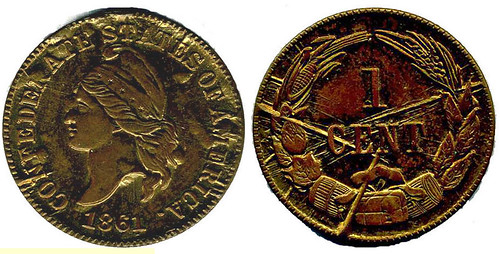
Authentic Thin Goldine
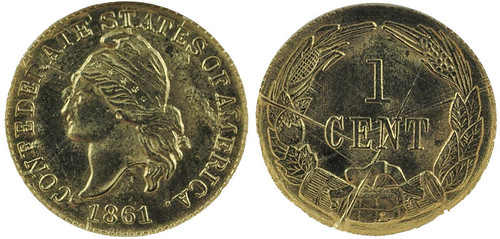
Fake Thin Gold
Mr. Laties still has his gold Confederate cent 2nd restrike, one was donated to the Smithsonian and Bashlow lost his piece. Dr. Doty of the Smithsonian has confirmed that the donated gold piece is still at the Smithsonian. Keep in mind that the Gold Confiscation Proclamation of 1933 was still in effect in 1962. Bashlow had already had a run-in with the Secret Service and was terrified of having another brush with them. This attitude has been confirmed by Mr. Laties.
The letter from Bashlow, mentioned above, provided some insights into some of the items that were struck. In particular, he mentioned that there were two or three thin planchet restrikes in silver and about six in bronze. He did not mention goldine, but that is not surprising since he mentioned reverse hub impression in goldine and bronze and failed to mention those in silver.

Laties Gold

You know, it is true that now and then a blind hog does find acorns. I now own one thin planchet silver and one goldine 2nd restrike. The thin planchet pieces were not weakly struck as some have argued. These pieces are as well struck as the thick planchet pieces. I have confirmed the provenance of these pieces as having come from Bashlow. I will be making a presentation to The Calumet Numismatic Club on June 16th and will show the diagnostic problems with the fake pieces.
To read the earlier E-Sylum article, see: BASHLOW'S CONFEDERATE CENT RESTRIKES (www.coinbooks.org/esylum_v09n46a20.html)
QUERY: CONFEDERATE CENT RESTRIKES IN OTHER METALS SOUGHT
On a related note a web site visitor writes:
I read your website article at: http://www.coinbooks.org/esylum_v10n18a15.html and, being the owner of several rare Bashlow 1 cent Confederate restrikes offer the following observations:
Regarding thin flan metals used, I have two, one a in a TOMBAC metal (90% copper, 9% zinc), which would be in Breen's "other metals", and the other in a "Nickel Silver" metal (66% copper, 18% nickel, 16% zinc, 0% silver).
I also have in my collection, Bronze, Silver, Goldine and PLATINUM which are thick flan, measured by NGC as 3.04 mm thick, measuring the edge of the plan and not including any high points of the devices.
I have an Aluminum one, but cannot determine its thickness without removing it from the holder, but I assume it is likely thick flan.
I am looking for the following other metals that are mentioned by Breen: Gold, Tin, Lead, Zinc, Red Fiber and any additional "other metals". Any information on sources for any of them will be most welcome.
I worked with NGC to have metal tests performed on most of my Bashlow cents, including both the common and rare ones. Goldine was found to have 85% copper, 15% zinc, and Silver was 90% AG and 10% CU.
To read the earlier E-Sylum article, see: BASHLOW GOLD CONFEDERATE CENT RESTRIKE INFORMATION SOUGHT (www.coinbooks.org/esylum_v10n18a15.html)
DICK JOHNSON: GLOSSARY TERMS OFTEN MISLEADING
Howard Daniel was exceptionally kind to send me this week his private file of glossary terms he has gathered over the years for his own wide-ranging numismatic pursuits. I can detect from his chosen word lists the extent of his curiosity as he lists words of philately, oriental items, banknotes, in addition to strictly numismatic items. I detect he is even interested in polymer as a modern trend replacing security paper for currency.
He captured the terms as he encountered them, recording them -- often in the words of the original writer -- other times rewriting it in his own words. Both are useful for his own private purposes. Learning technology and terms of the field dramatically widens your numismatic knowledge. Never overlook an opportunity to learn a new word. It heightens your understanding by being able to think in new ideas, new concepts, and be more precise in thinking of old concepts.
In my first glance at his list I detected a far too common flaw. The fuzzy thinking of the original writer. The world "Lamination," for example, gives the exact opposite definition for the term. Here is what Howard found and recorded:
Howard, the careful scholar he is, also recorded the source of where he found that definition: Coin World, March 29, 1999, page 82, "Back to Basics, Useful information for collectors, Numismatic Terms, A working glossary for coin collectors."
Lamination is the application of a layer of medal. What was published was the definition for the word DELAMINATION -- the error most encountered for coins of this anomaly.
Once you learn the words your mind has expanded. You can and should use that new knowledge to question everything you read.
Perhaps, that includes what I have written as well.
POLITICAL SHAKEUPS AT THE U.S. MINTS
In last week's review of Gold in His Veins: The Story of John Daggett, Dave Lange wrote:
The above from David Lange's comments reminds one of the situation that accounted for the stoppage of coin production at the Carson City Mint between 1885-89. President Cleveland, in his first term, fired all the employees of the mint who were Republicans and presumably unsupportive of the (dimensionally) great man.
Coinage resumed once Republican Benjamin Harrison replaced Cleveland and then his Democrat place holders at the mint. And so Cleveland got to do it all over again in the San Francisco Mint during his second term. I guess Grover gets points for consistency, if nothing else.
To read the earlier E-Sylum article, see: BOOK REVIEW: GOLD IN HIS VEINS: THE STORY OF JOHN DAGGETT Back to top
QUERY: 2008, 2010 SPECIAL EDITION RED BOOKS
Regarding special editions of A Guide Book of United States Coins, Carl Binder writes:
I am a weekly subscriber to The E-Sylum which I look foreward to reading each week. I am seeking information on two Red Books. Who can I contact?
1) A limited edition to be made available this spring for the Boston Numismatic Society
2) A 2008 special Limited Leather Bound Edition which incorporated a special bookplate honoring the 150th anniversary of the American Numismatic Society and handed out at the celebratory dinner on January 10, 2008.
I went straight to the source and forwarded Carl's query to Dennis Tucker of Whitman Publishing, who writes:
Charlie Davis helped coordinate the Boston Numismatic Society's special 150th-anniversary edition of the Red Book. I believe the Society has plans to sell the book as a fundraiser; Charlie would be able to provide more specifics (Numislit@aol.com).
The 2008 ANS Limited Edition will probably be very rarely seen in the marketplace, since it was distributed to a small number of people for their personal collections. It was never offered for sale; each recipient got one (and only one) copy, as a memento of a historic occasion (the sesquicentennial of the American Numismatic Society). It might be a generation or two before any copies appear publicly for sale or auction. However, a collector might make inquiries to members of the ANS who were present at the dinner.
QUERY: MERKIN, CHAPMAN AND LIMPERT PHOTOS SOUGHT
Benny Bolin writes:
Does anyone have pictures of Lester Merkin, S.H. Chapman or Dr. Limpert? I need them for an exhibit at the Memphis Paper Money show. It's a fractional currency exhibit titled "Great Notes from Great Collections/Sales." I hope to have pictures of most of the past owners of notes that I have along with the actual auction descriptions.
 I've located two of the three. There is a nice line drawing of Samuel H. Chapman on p90 of United States Numismatic Literature, Volume I by John W. Adams (1982). Does anyone have a portrait photo?
I've located two of the three. There is a nice line drawing of Samuel H. Chapman on p90 of United States Numismatic Literature, Volume I by John W. Adams (1982). Does anyone have a portrait photo?
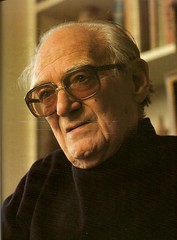 As for Merkin, there are several nice photos in Mark Van Winkle's An Interview with Lester Merkin in the Spring 1989 issue of Legacy magazine from Heritage.
As for Merkin, there are several nice photos in Mark Van Winkle's An Interview with Lester Merkin in the Spring 1989 issue of Legacy magazine from Heritage.
But Limpert? Can anyone help? Limpert's book, United States Paper Money Old Series, 1861-1923, was published in 1948. Dr. Frank A. Limpert lived in Royal Oak, Michigan; perhaps some local Michigan coin publications would have a photo of him. -Editor
QUERY: UNKNOWN COPPER TOKEN IDENTIFICATION SOUGHT
Saul Teichman writes:
I wonder if any of the E-sylumites can determine what this token or game counter is. It's copper, about the diameter of a Morgan silver dollar and about as thick as a dime. The same design is on both sides, except that the initials JS are at the bottom on one side. There are no other dates, writing or mintmarks anywhere on the piece. There are 16 berries on the wreath, on each side. (32 front, 32 back).
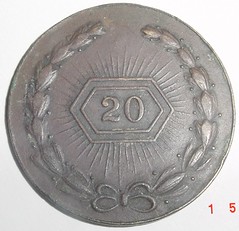
THE EMERGENCY MONEY COLLECTOR, VOL. 2 NO. 2
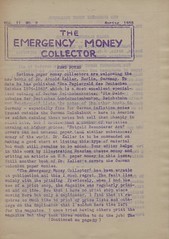 Arlie apologizes for the erratic publication schedule of the magazine. The magazine now consists of 24 pages.
Arlie apologizes for the erratic publication schedule of the magazine. The magazine now consists of 24 pages.
“U.S. Civil War Paper Money Printed on Substitute Paper” by Arlie Slabaugh. During the U.S. Civil War many different kinds of paper were used in the Confederate States to print banknotes. With the blockage and little paper making capability, the South often had to resort to extreme measures. Materials used included the backs of bills of exchange; backs of old notes; plain paper, wall paper, and envelops. What follows are 6 pages listing notes by state, county, town and private enterprises.
Russian Cheese Money. Very little is known of this currency except that it was issued during WWI by stamping cakes of cheese with a seal and value in indelible ink. The seal was of dancing girl or fairy(?). The pieces were about 3” X 5”. Apparently very rare. Arlie wants to know if any reader knows of another specimen.
Hungarian Inflation Money by Charles Z. Mihlyi. Many countries have gone down in history as issuing large denomination notes, Germany and Russia after WWI, Greece and China recently (keep in mind this is 1953). But, Hungary in 1949 reached astronomical heights. As banknotes of a million pengos proved inadequate, “mil-pengo” notes were issued (notes of multiples of a million). Then “bil-pengo” notes (notes of a quadrillion pengos). Finally, the “Ado-Pengo” or “Tax Note”. These were notes to be used as currency and, depending on the issue date, could be used to pay taxes. One assumes this means their value was guaranteed for tax purposes.
Chapter IV of “Russian Emergency Paper Money” by Vladimer M. Oushkoff is presented. This eight page chapter discussed the emergency paper money in the Crimea and Southeast Russia. The Germans occupied the Crimea until 1918 and issued few notes. The author relocated to the Crimea in autumn 1919 and writes of his observations. Many local issues consisted of state bonds with the inscription informing the bearer that the bond was legal tender. The next region covered was the North Caucasus. This was a small region with many local issues because of the diversity of the population and the civil war.
The eighth region covered is the Transcaucasus. This is an area where 24 different languages were spoken. In addition, the population was very independent and did not want to join Soviet Russia.
Dr. Arnold Keller of Berlin-Wittenau, Germany, writes ”WANTED: To add to my collection of 150,000 pieces of paper money of all countries. I desire to exchange with the USA. I am looking for state and bank notes and POW notes and tickets.” (Note: Is this is the same Arnold Keller who is mentioned in the GRAM of March 29th as being elected to the IBNS Hall of Fame?) Also, Elmer Wright of Champagne, Illinois, wants to buy POW money and Civil War Sutler's tokens.
To read the earlier E-Sylum article, see: THE EMERGENCY MONEY COLLECTOR, VOL. 2 NO. 1 (www.coinbooks.org/esylum_v13n15a09.html)
MICHAEL MAROTTA ON NUMISMATICS AND THE LAW
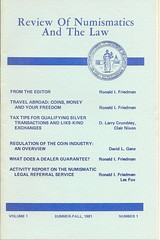
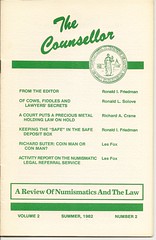
Wayne Homren was kind enough to let me see these four academic-style journal volumes from 1981-1982. They are evidence of both the permanence and transience of issues in our hobby. Review of Numismatics and the Law and its successor, The Counsellor (sic), were published by Carson City Publications of Midland Park, New Jersey. The editor and principal author was Ronald I. Friedman.
Other articles were the work of D. Larry Crumbley, Clair J. Nixon, Eileen P. Friedman, Allen Kamp, Les Fox, William M. Egbert, Ron Solove, Juan Impuestsos, (“John Tax,” pen name for an IRS agent), and David L. Ganz.
Ronald I. Friedman was a professor at the law school of Capital University in Columbus, Ohio. Les Fox ran Carson City Publishers. Solove was a professor of law; Eileen Friedman graduated from law school; Crumbly and Nixon were professors of accounting; Crane and Egbert were attorneys. This was a proficient faculty.
Volume 1 Number 1 carried a warning to attorneys: “Because most of our readers are not attorneys it has been decided not to clutter up the Review with legal citations to cases, statutes and the like.” Personally, I believe that this allowed them to make themselves the experts of record. The Bluebook mode of legal citation favors brevity. For instance, “Tips on collecting classic proof coins,” by Q. David Bowers, The Numismatist, Vol. 108, no. 1 (Jan., 1995), p. 77-79 and Vol. 108, no. 2 (Feb., 1995), p. 203-206, would be “Bowers, Num. 108, 1-2.” It is not insurmountable.
Overall, these articles (25 in four volumes) had little to with numismatics per se and much to do with legal topics that concern us: taxation, safe deposit boxes, metal detecting, travel abroad and buying abroad, sunken treasure, and precious metals. Of course, the law changes. Nonetheless, these 30-year old articles do address questions that we still have.
A shift in editorial policy was obvious when The Review of Numismatics and the Law became The Counsellor. The back cover of Volume 2 Number 1 listed “Dealers We'd Like to Know More About … For Our Files.” Among the suspects were The Old Roman, Jules, Karp, and Foothills Coins.
Via their reports from their own Numismatic Legal Referral Service, the publication also took to task Steve Ivy Rare Coins, Ed Rochette and the ANA, Coin World, Clifford Mishler and Krause Publications, and Bowers and Ruddy. They made a special case of Richard Suter of Three Rivers Coins. In addition to listing him along with the other rogues, Les Fox wrote “Richard Suter: Coin Man or Con Man” for Volume 2 Number 2.
To read the earlier E-Sylum article, see: MORE ON A REVIEW OF NUMISMATICS AND THE LAW (www.coinbooks.org/esylum_v13n15a06.html)
NOTES FROM E-SYLUM READERS: MAY 9, 2010
Dick Hanscom writes:
Concerning the new $100 bill - isn't it great that the Treasury gave such a nice description a year ahead of release so the counterfeiters could start gearing up for production? Perhaps this is not a legitimate fear, but I think it would be perfect for the small time counterfeiter, perhaps not for the North Koreans.
Phil Iversen writes:

Bob Leonard writes:
 Even though I am not receiving royalties, I have been shamelessly promoting my book "Curious Currency" all over the place. I have arranged for a book signing at a local independent book store, The Book Stall at Chestnut Court, 811 Elm St., Winnetka, IL, for Wednesday, June 23, at 7:00 p.m.
Even though I am not receiving royalties, I have been shamelessly promoting my book "Curious Currency" all over the place. I have arranged for a book signing at a local independent book store, The Book Stall at Chestnut Court, 811 Elm St., Winnetka, IL, for Wednesday, June 23, at 7:00 p.m.
I know that Fred Reed (on his own) set up a couple of book signings last year for his book, "Abraham Lincoln: The Image of His Greatness", one at the Abraham Lincoln Book Store.
Jessica Mullenfeld of Zyrus Press writes:
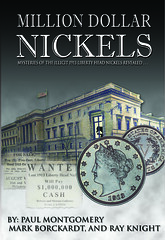 That new show on The Learning Channel, Accidental Fortune is doing a segment on the Walton nickel and it's supposed to air on May 13th. We're pretty excited about it because hopefully it'll increase sales for our book Million Dollar Nickels.
That new show on The Learning Channel, Accidental Fortune is doing a segment on the Walton nickel and it's supposed to air on May 13th. We're pretty excited about it because hopefully it'll increase sales for our book Million Dollar Nickels.
NBS webmaster Bruce Perdue writes:
I just returned from the 72nd CSNS Convention in Milwaukee. I was working on the loading dock as CSNS's representative to facilitate the unloading of vehicles, so I saw Orville Grady, Pete Smith and Howard Daniel to mention a few NBS members I saw. I was pleased to have the opportunity to speak at length with Howard Daniel who is always a delight to chat with. I even assisted John Burns in loading his vehicle so he could get on the road as quickly as possible. It is amazing the quantity of numismatic literature he moves around the country.
I would also like to thank NBS members and E-Sylum readers for their votes in the CSNS election as I am now a CSNS Board member for the next two years. speaking of the CSNS their publication, "The Centinel" is always looking for submissions on numismatics. I did get to spend some time with Gerry Tebbens who took over when Rollie Finner passed away last fall. He in particular is looking for YN submissions, however all submissions are welcome.
In regards to the Heberden Coin Room at the Ashmolean Museum: I was just in Oxford visiting my son who is getting his Masters Degree in Medical Anthropology this summer. (Actual graduation ceremony is September) While there we visited the Pitts River Museum that Ute Wartenberg Kagan mentioned in the article. I can attest to the huge quantity of anthropological material as it is my sons favorite museum and he took me there. The cases are jam packed with material and is as it was in my mind at least over one hundred years ago. Truly an amazing collection.
We were headed to the Ashmolean Museum, but weary legs, time and rain filled clouds conspired to send us in a different direction. I hope to return to visit Oxford again and will make sure to visit the Heberden Coin Room at the Ashmolean Museum.
One last item from the CSNS convention. I had the opportunity to spend a few minutes with Andrew Keene a YN, who is a volunteer ANA District Representative. He showed me some apps on his iPhone that relate to numismatics. One was no surprise it shows current precious metals prices, one lets you select any US denomination banknote and it will show you an image of the current note and allows you to look at previous notes. I don't know how far back it goes, but it was impressive. The third was a currency conversion app that also shows you what the banknotes of the country look like. Truly amazing technology. Is there an app for bibliomanics?
QUERY: NEW ENGLAND NUMISMATIC AND ARCHAEOLOGICAL SOCIETY PRLS
Sylvester Crosby was a leading member of the New England Numismatic and Archaeological Society. The Society planned to write a book on The Early Coins of America, and a committee was formed with Crosby as the chairman. But it did not turn out that way. He received little or no help from the rest of the committee. Crosby later wrote that had he known that all the work of the book would fall upon him, he never would have started the project. Perhaps strained relations over this led to the end of the society.
The Society's logo lists the states of New Hampshire, Vermont, Massachusetts, Rhode Island, Connecticut and Maine, but it seems most meetings were held in Boston. The American Journal of Numismatics published reports of some of their meetings. I believe that they disbanded in the late 1870's, but I am not sure when.
I have a set of List of Prices (Realized ) of New York coin sales issued by the New England Numismatic & Archaeological Society, with their logo on page one. I have numbers 1 thru 7. Is this a complete set, or are there more? Could any of the E-Sylum readers help me with this?
The PRL's that I have are
- #1 Cauffman sale 5/3/1871,
- #2 B. Betts sale 6/1/1871,
- #3 Nexsen sale 10/5/1871,
- #4 Clay sale 12/5/1871 (this one was priced at 75 cents, higher than their usual 25 cents)
- #5 Furman sale 12/12/1872
- #6 Haseltine 12/18/1872,
- #7 Bangs Leveridge sale 1/28/1873.
I believe the reason for these was that dealers at that time did not usually issue PRL's. You had to pay them to price a catalog for you. I think this was an attempt to supply sale results at a more reasonable price.
QUERY: COLLECTORS OF CANADIAN TOKENS AND MEDALS SOUGHT
New subscriber Jeff Fournier writes:
I'm looking to contact other collectors of Canadian material for trading etc....(municipal and coin club medals, tokens and so forth). I've been collecting for quite a while, but have been inactive for several years and have lost contact with many collectors, so I'm at a bit of a loss trying to track them down. Any help you could offer would be greatly appreciated.
MORE ON THE PAPERS OF CHARLES EDWARD BARBER
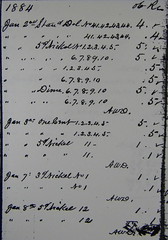
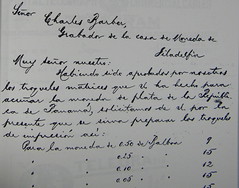
To read the earlier E-Sylum article, see: THE PAPERS OF CHIEF ENGRAVER CHARLES EDWARD BARBER (www.coinbooks.org/esylum_v13n17a11.html)
QUERY: FRANCIS SHALLUS, PHILADELPHIA ENGRAVER
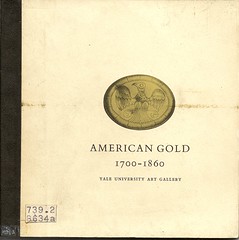 While sorting thru some things in my library recently, I came across a copy of "American Gold 1700-1800", a 1963 monograph by Peter Bohan based on a loan exhibition. While the exhibit focused on everyday objects such as snuff boxes, spoons, thimbles, rings and belt buckles, the monograph is in my library because of the medals. Three are illustrated and about eight in all are listed.
While sorting thru some things in my library recently, I came across a copy of "American Gold 1700-1800", a 1963 monograph by Peter Bohan based on a loan exhibition. While the exhibit focused on everyday objects such as snuff boxes, spoons, thimbles, rings and belt buckles, the monograph is in my library because of the medals. Three are illustrated and about eight in all are listed.
Two of the medals are attributed to Philadelphia engraver Francis Shallus. Has his medallic work been documented elsewhere? I was unable to find a single entry related to Shallus in NIP, the Numismatic Indexes Project.

One of the medals is dated 1807. The inscription "MRS RIVARDI'S SEM PHILADELPHIA 1807" refers to "Mrs. Rivardi's Seminary". On the obverse the name of Victorine Dupont de Nemours is inscribed. Victorine (1792-1861) was the daughter of E.I. du Pont. The medal was loaned to the exhibit from the Winterthur Museum.

The other Shallus piece is a Masonic medal dated 1812. It was lent by the Henry Ford museum. Below are a couple Internet references I found on Shallus. It's interesting to see his connection to Robert Scot. Can anyone tell us more about him, or provide images of his medals? The images in the monograph are small and unclear.
From "Ann Shallus's Circulating Library" by Karen Nipps (Library Company of Philadelphia), originally published in Journal of Library History, vol. 26, no. 4 (Spring 1991): 608-610.
Francis Shallus, engraver of the Shallus's Circulating Library bookplates, is first listed in the Philadelphia city directory as an engraver in 1797. Francis, son of Jacob Shallus (believed to be the scrivener who engrossed the United States Constitution), was a reputable craftsman and an active participant in Philadelphia's lively literary and publishing circles.
He is noted for being a principal engraver For Thomas Dobson's acclaimed 18-volume Encyclopaedia (1798), Benjamin Smith Barton's ground-breaking Elements of Botany (1803), and numerous other plate books; he did all forty-one plates for the 1818 Philadelphia edition of The Voyages of Captain Cook.
He engraved city views, maps, and atlases and also has been identified as the engraver of a number of medals, including ones for the Philadelphia Typographic Society and the Masons. He producer innumerable engraved trade cards and bookplates by fellow Philadelphians. He also executed aquatints and even tried his hand at publishing.
To read the complete article, see: Ann Shallus's Circulating Library (www.gslis.utexas.edu/~landc/bookplates/28_3_Shallus.htm)
From "A Checklist of the Work of Francis Shallus, Philadelphia Engraver" by Mary E. Holt, Winterthur Portfolio, Vol. 4, (1968), pp. 143-158
During the 1790's Shallus worked for, and may have been apprenticed to, Robert Scot, the first engraver employed by the Philadelphia Mint.
To read the complete article, see: A Checklist of the Work of Francis Shallus (www.jstor.org/pss/1180492)
THE BOOK BAZARRE
GIANT CHINESE COIN OF LE DYNASTY FOUND
Tran Van Hoc, a farmer in Hong Linh town, which is located in the central province of Ha Tinh, picked up a giant ancient coin while he was working in the field.

Researchers said that this coin is from the Le Dynasty (1740-1786). The bronze coin is much bigger than normal coins. Its diameter is 12cm and it weighs 30gr. There is a square-shaped hole in the centre.
There are four Chinese scripts on one side, meaning "Canh Hung coin", and eight Chinese scripts on the other side, meaning "stability inside, peace outside, wealthy country and powerful army".
According to historians, this coin was not for circulation but was a symbolic coin. The Le Dynasty presented this coin to men who greatly contributed to the country.
To read the complete article, see:
Ha Tinh farmer unearths a giant ancient coin
(yvietnam.blogspot.com/2010/05/ha-tinh-farmer
-unearths-giant-ancient.html)
ARTICLE ON STATE DEPARTMENT'S COIN IMPORT RESTRICTIONS
 They're only worth about $275, but 23 bronze coins seized by the federal government at Baltimore-Washington International Marshall Airport last year just might be the most important chunk of change for numismatists in years.
They're only worth about $275, but 23 bronze coins seized by the federal government at Baltimore-Washington International Marshall Airport last year just might be the most important chunk of change for numismatists in years.
These well-worn coins, struck more than a thousand years ago in Cyprus and China, are at the center of a dispute over U.S. rules that collectors across the country say could threaten their popular and beloved hobby.
For generations, collectors have freely bought and sold coins from around the world, including many from ancient times. But the United States in recent years began restricting imports of some coins as part of a broader effort to protect antiquities and combat the looting of archaeological sites abroad.
It began with some Cypriot coins in 2007, then certain Chinese coins were added last year. But numismatists are worried that Roman coins, the passion of many collectors, could be next to join the list.
So the Missouri-based Ancient Coin Collectors Guild bought the 23 bronze coins in April last year from a London dealer, solely to challenge the rules and set off a legal showdown over requirements that people show proof of where or when certain coins are unearthed.
In a lawsuit filed February in Maryland federal court, the collectors say presidents John Quincy Adams, Thomas Jefferson and Ronald Reagan were ancient coin collectors. Most coins, they contend, were so widely circulated in ancient times that it might be impossible to know when they were dug up. Plus, they argue, the rules will do little to discourage plundering because they apply only to U.S. collectors.
Wayne G. Sayles, a longtime collector and guild executive director, said he agrees that some antiquities -- such as religious icons, mummies and precious artwork -- need the government's protection and belong to the people of the country in which they were found. But he thinks coins are different. Most aren't high-dollar items, he says, and collectors keep, study and protect coins that museums don't want.
"Do I think that the Liberty Bell ought to be sold to somebody in Russia? No, it belongs here. I understand that, and I agree with that. But we're not talking about the Liberty Bell," Sayles said.
To read the complete article, see:
For some coin collectors, federal regulations don't add up
(www.washingtonpost.com/wp-dyn/content
/article/2010/05/07/AR2010050705046.html)
IN POLL CANADIANS VOTE AGAINST KEEPING THE CENT
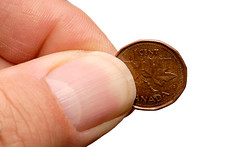 The penny has outlived its usefulness and should be scrapped, says P.E.I. Senator Catherine Callbeck.
The penny has outlived its usefulness and should be scrapped, says P.E.I. Senator Catherine Callbeck.
Callbeck is on the Senate's national finance committee, which is preparing a report on the value of the penny. On cost of production alone, it represents a loss for Canadians, Callbeck told CBC News.
"The raw material in the production of the penny costs more than a penny, so that roughly the direct loss to the taxpayer every year is $25 million," said Callbeck. She said the Senate wants to hear from Canadians on the issue.
To read the complete article, see:
Penny: Is it time to get rid of the one-cent coin?
(www.cbc.ca/news/pointofview/2010/05/penny
-is-it-time-to-get-rid-of-the-one-cent-coin.html)
To read the earlier E-Sylum article, see: CANADIAN PARLIAMENT STUDIES ABOLISHING CENT COIN (www.coinbooks.org/esylum_v13n18a20.html)
SHADES OF STANDING LIBERTY: VIRGINIA'S BARE BREAST COVERED
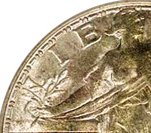 Dick Johnson forwarded this article about a kerfuffle over the Virginia Attorney General's choice of design for a pin based on the state's official seal, which brings to mind the (apocryphal) dust-up over Miss Liberty's exposed breast on the 1916 Standing Liberty Quarter.
-Editor
Dick Johnson forwarded this article about a kerfuffle over the Virginia Attorney General's choice of design for a pin based on the state's official seal, which brings to mind the (apocryphal) dust-up over Miss Liberty's exposed breast on the 1916 Standing Liberty Quarter.
-Editor
Attorney General Ken Cuccinelli apparently isn't fond of wardrobe malfunctions, even when Virginia's state seal is involved.
The seal depicts the Roman goddess Virtus, or virtue, wearing a blue tunic draped over one shoulder, her left breast exposed. But on the new lapel pins Cuccinelli recently handed out to his staff, Virtus' bosom is covered by an armored breastplate.
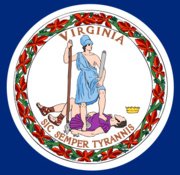
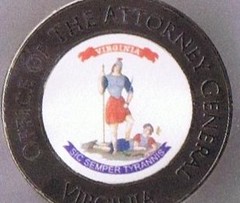
When the new design came up at a staff meeting, workers in attendance said Cuccinelli joked that it converts a risque image into a PG one.
The joke might be on him, said University of Virginia political scientist Larry Sabato.
"When you ask to be ridiculed, it usually happens. And it will happen here, nationally," he said. "This is classical art, for goodness' sake."
Cuccinelli's spokesperson said the pins depicting the version preferred by the state AG were paid for by his political action committee, not taxpayers. That's nice, I suppose, but it's not really the point of what makes this interesting.
If this seems strangely familiar, I should note that then-U.S. Attorney General John Ashcroft did something similar a few months after 9/11, when he covered up bare-breasted statues in the main hall at the Department of Justice with blue drapes.
To read the complete article, see: THE CUCCINELLI CRUSADE CONTINUES.... (www.washingtonmonthly.com/archives/individual/2010_05/023605.php)
Cuccinelli issued a statement about his decision:
The seal on my pin is one of many seal variations that were used before a uniform version was created in 1930. I felt it was historic and would be something unique for my staff. My joke about Virtue being a little more virtuous in her more modest clothing was intended to get laughs from my employees — which it did! Just because we've always done something a certain way doesn't mean we always have to continue doing it that way. Now seriously, can we get on with real news?
To read the complete article, see: Attorney General Saves Virginia from Breasts (gawker.com/5529962/attorney-general-saves-virginia-from-breasts)
BOOK QUOTE OF THE WEEK: JOHN RUSKIN
John Ruskin:
All books are divisible into two classes, the books of the Hour, and the books of all Time.
MOTHER'S DAY COMMEMORATIVE COIN ACT PASSES U.S. HOUSE
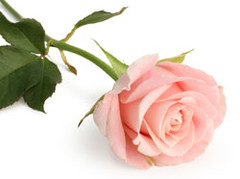 On May 5, 2010, H.R. 2421: Mother's Day Centennial Commemorative Coin Act passed in the House of Representatives. The bill would require the Secretary of the Treasury to mint and issue commemorative silver dollars to mark the 100th anniversary of the establishment of Mother's Day.
On May 5, 2010, H.R. 2421: Mother's Day Centennial Commemorative Coin Act passed in the House of Representatives. The bill would require the Secretary of the Treasury to mint and issue commemorative silver dollars to mark the 100th anniversary of the establishment of Mother's Day.
H.R. 2421 was first introduced on May 14, 2009 by Rep. Shelley Capito of West Virginia. A similar bill had been introduced in the Senate a week earlier on May 7, 2009 by John Rockefeller of West Virginia.
If one of these bills becomes law, up to 400,000 of the Mother's Day Silver Dollars could be minted and issued for 2014. The coins would feature a design emblematic of the 100th anniversary of President Wilson's proclamation designating the second Sunday in May as Mother's Day. The designs would be selected by the Secretary of the Treasury after consultation with the Commission of Fine Arts and review by the Citizens Coinage Advisory Committee.
Each coin would be minted in 90% silver and 10% copper with a diameter of 1.5 inches and weight of 26.73 grams. Both proof and uncirculated versions of the coin would be produced. The coins may be issued beginning on January 1, 2014. No coins may be minted after December 31, 2014.
To read the complete article, see:
Mother's Day Commemorative Coin Act Passes House
(news.coinupdate.com/mothers-day-commemorative-
coin-act-passes-house-0265/)
FEATURED WEB SITE: NATIONAL MARITIME MUSEUM
This week's Featured Web Site is the coins and medals section of the National Maritime Museum in Greenwich, England.
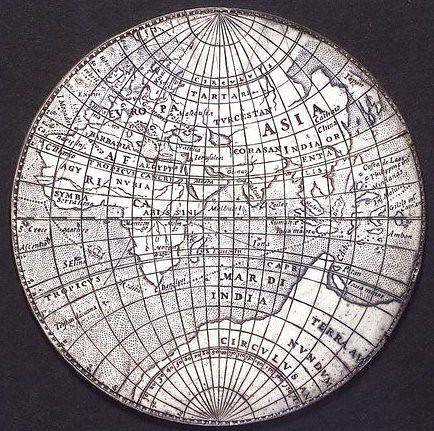
There are approximately 5000 coins and medals with a maritime or Greenwich association in the National Maritime Museum's collection. The collection owes its existence to a group of private medal collectors with an interest in naval history.
Apart from a small group of Roman coins, most of the collection dates from the 15th to the 20th century. The collection includes Orders and decorations from all over the world, British war and gallantry medals and art medals from Europe and North and South America.
Highlights include a medal by Michael Mercator showing the track of Drake's circumnavigation, some of the German medals designed during the First World War by Karl Goetz and a Victoria Cross awarded to Captain William Peel (1824-58).
George Montagu, 9th Earl of Sandwich (1874-1962) presented his private collection to the Museum during the 1930s. It included foreign commemorative medals, Roman coins and a collection of French counters or jetons. He also produced a published catalogue that forms the basis of our online collection.
www.nmm.ac.uk/collections/explore/
index.cfm/category/medals

